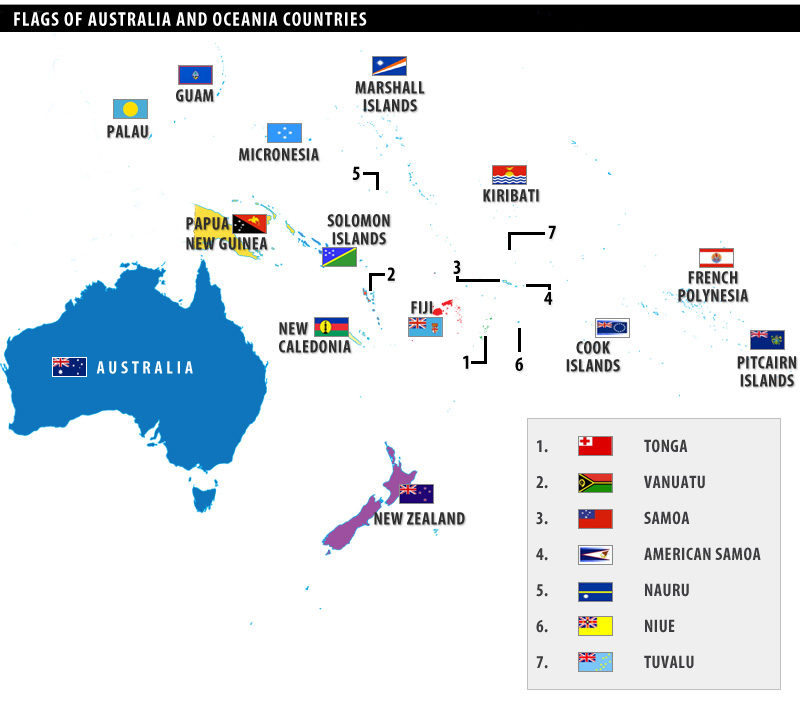
Description : Map showing the national flags of Australia and Oceania countries.
| Country | Flag | Symbol Meaning |
|---|---|---|
| Australia |  |
The flag features a dark blue field with the Union Jack in the canton, representing Australia’s historical links to the United Kingdom, and a large white seven-pointed star known as the Commonwealth Star, symbolizing the federation of states. |
| Fiji | 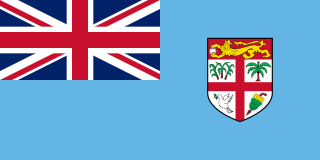 |
The flag consists of a light blue field with the national coat of arms, featuring a golden British lion, a sugarcane plant, coconut palm, dove of peace, and a bunch of bananas, symbolizing Fiji’s history, agriculture, peace, and national identity. |
| Kiribati |  |
The flag features a red field with a golden frigatebird flying over a sun, symbolizing strength, freedom, and Kiribati’s location on the equator. |
| Marshall Islands |  |
The flag consists of a blue field with two diagonal stripes – the top stripe is orange, and the bottom stripe is white. The orange stripe represents bravery, wealth, and the sun, while the white stripe symbolizes purity and peace. |
| Micronesia | 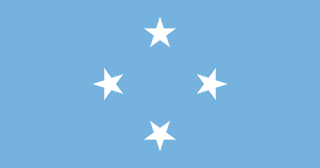 |
The flag features a light blue field with four white five-pointed stars representing the four states of Micronesia – Chuuk, Kosrae, Pohnpei, and Yap. The stars symbolize the unity and political equality of the states. |
| Nauru | 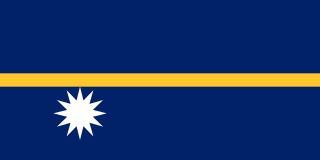 |
The flag consists of a blue field with a narrow, horizontal, yellow stripe across the top edge, and a white 12-pointed star in the bottom hoist-side corner, representing the twelve indigenous tribes of Nauru and the country’s location near the equator. |
| New Zealand |  |
The flag features a dark blue field with the Union Jack in the canton, representing New Zealand’s historical ties to the United Kingdom, and four red stars with white borders known as the Southern Cross, symbolizing navigation and the country’s location in the Southern Hemisphere. |
| Palau |  |
The flag consists of a light blue field with a golden circle in the canton representing the moon, and a larger golden circle beneath it symbolizing Palau’s full moon. The blue field represents freedom, authority, and the Pacific Ocean. |
| Papua New Guinea |  |
The flag features a red field with a black diagonal stripe from the upper hoist-side corner to the lower fly-side corner. The red represents the bloodshed of the country’s past, and the black represents the people’s determination to move forward. |
| Samoa |  |
The flag consists of a red field with a blue rectangle in the canton, bearing the Southern Cross constellation represented by five white five-pointed stars. The red represents courage, and the blue represents freedom and loyalty. |
| Solomon Islands |  |
The flag features a blue field with a yellow-fringed green diagonal stripe from the upper hoist-side corner to the lower fly-side corner. The blue represents the ocean, and the green symbolizes the land and the country’s agricultural resources. |
| Tonga | 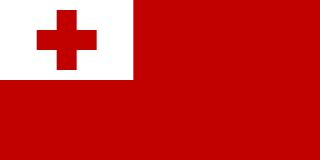 |
The flag consists of a red field with a white square in the canton, bearing a red Greek cross known as the Cross of Saint George. The red represents the blood of sacrifice, and the white symbolizes purity, loyalty, and the Christian faith. |
| Tuvalu |  |
The flag features a light blue field with nine yellow stars representing the nine islands of Tuvalu. The stars are arranged in a pattern symbolizing the country’s geographical location and the waves of the ocean. |
| Vanuatu | 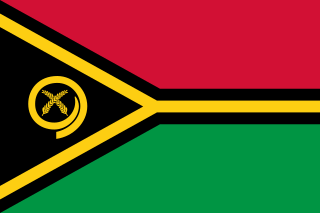 |
The flag consists of a green field with a red horizontal band at the hoist side, and a black triangle pointing towards the fly side. The green represents the richness of the islands, the red symbolizes the blood of the people, and the black triangle represents the Ni-Vanuatu people. |
Reference: wiki
